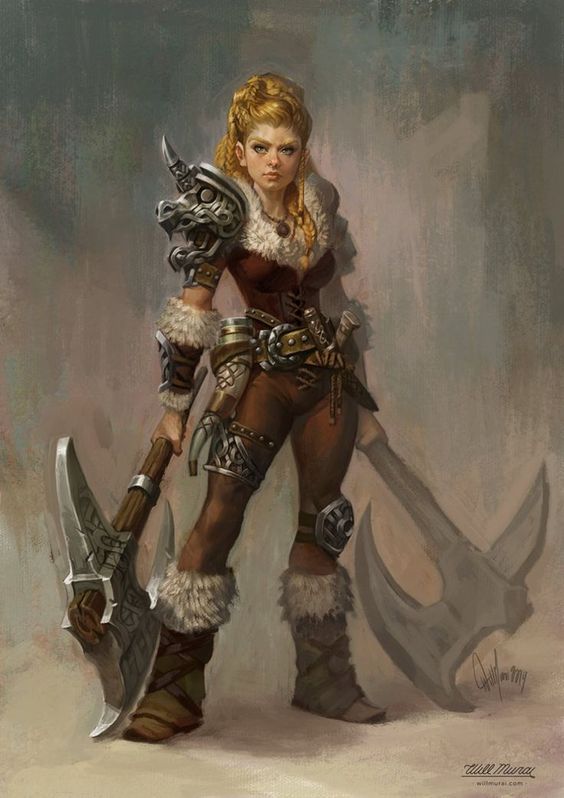A dual wielding 5e guide is something I tried to find whenever I was a Rogue class who wanted to fight with two short swords. What confused me was what feats I should take to make my dual-wielding useful.
Dual-wielding can work for any character, but to make the most of it, you should learn everything you can about it. I love learning about new concepts and potential builds in Dungeons and Dragons, and I hope you do too.
The Downlow on Dual Wielding 5e
Dual-wielding in D&D 5e is something you may consider if you play a melee class that doesn’t use many spells. The bottom line is that if you use light melee weapons and don’t use your bonus action often, you can benefit early on from dual wielding.
However, dual-wielding may not be a great choice if you are a spellcaster, someone with a lot of great bonus actions, or someone who uses two-handed weapons. In the end, however, the choice is yours.
I wholeheartedly believe that the majority of character creation in DnD should be about roleplaying. Minmaxers have their place, but those who can really get into character and role with their imperfections are my heroes.
What is Dual Wielding in Dungeons and Dragons 5e?

- Weapon Requirement – Light
- Dual Wielding Title – Two-Weapon Fighting
- Classes That Can Dual Wield – Any
Dual wielding is fighting with a weapon in each hand. It really is as simple as that description. This is true for real life and in Dungeons and Dragons 5e. Whenever you dual wield, your initial attack will be stronger than your second attack.
The first attack is made with your on-hand (the hand you use when only wielding one weapon), and it has full power. Depending on your ability modifier, the second attack is generally a bit weaker.
This is a realistic way to take on dual wielding. It reminds me of the swordfight scene between Inigo Montoya and Westley. In the scene, both fighters start the fight left-handed before revealing that they are both right-handed later on.
This insinuates that they weren’t using their full strength and would gain a power boost once they switched hands. The same would happen if you were to switch hands in Dungeons and Dragons.
My Experience With Dual Wielding
When I dual-wielded, I was a Rogue with shortsword wepaons. Dual wielding is something I do in any game that I can. I did it in Elden Ring; I do it in just about every RPG I can. Whenever I watched Sword Art Online, and Kirito was the first to dual wield, it broke my heart.
How could no one else have thought about it yet? It’s my first instinct. Although I was told that dual wielding as a Rogue wasn’t ideal, I went with it, and I’m glad I did. In fact, I’ve never regretted a build decision in DnD because they always come from the heart and my passion for my character.
How to Dual Wield in D&D 5e
The proper term for dual wielding in Dungeons and Dragons is Two-Weapon Fighting. However, I will use the term dual wield synonymously in this guide to prevent confusion.
To dual wield in 5e, there’s only one base requirement: both weapons must be “light” weapons. There are no other requirements for dual-wielding, but there are specifications that can be enhanced via feats.
Light Weapons
| Weapon | Weight | Base Cost | Damage | Properties |
| Club | 2lbs | 1 Silver | 1d4 bludgeoning | Light |
| Dagger | 1lb | 2 Gold | 1d4 piercing | Finesse, light, thrown |
| Handaxe | 2lbs | 5 Gold | 1d6 slashing | Light, thrown |
| Light Hammer | 2lbs | 2 Gold | 1d4 bludgeoning | Light, thrown |
| Sickle | 2lbs | 1 Gold | 1d4 slashing | Light |
| Scimitar | 3lbs | 25 Gold | 1d6 slashing | Finesse, light, martial |
| Shortsword | 2lbs | 10 Gold | 1d6 piercing | Finesse, light, martial |
| Crossbow, hand | 3lbs | 75 Gold | 1d6 piercing | Ammunition, light, loading, martial |
Martial vs Simple Weapons: simple weapons can generally be used by anyone. However, martial weapons require special training. Some classes start the game with martial weapon proficiency. These weapons tend to weigh more – and still be light – and cost more than simple weapons.
Crossbow Problem: although you can technically dual-wield hand crossbows, it’s not a great idea. You need your extra hand to reload your hand crossbow. So it only works out for one shot, perhaps during an ambush. But after that, it’s pretty moot.
Attacking while Two-Weapon Fighting
When you dual-wield – without taking feats into consideration – you must make your attack action with one of your light weapons. Then, as a bonus action, you can use the other weapon to attack.
However, you do not add your ability modifier to the second attack unless your modifier is negative. Then you must add the negative; this will take damage away from the attack.
Rules of Two-Weapon Fighting
- Drawing Weapons – you can draw your primary weapon as part of your attack or movement action. However, to draw the second weapon, you must use a full action. This only matters the first turn, but that could be important.
- Dual Wielding as a Spellcaster – dual wielding as a spellcaster will take quite some time to master. You may need both hands to grab ingredients or cast spells when you’re a spellcaster.
- Bonus Action Override – you can only have one Bonus Action per turn unless an ability states otherwise. Don’t jump for the second attack if something else you have is better suited for the fight.
- Throwing – if the weapon is Light and has Throwing, you can throw it when you attack with it. This doesn’t change just because you are dual-wielding.
Dual Wielding Feats 5e and More

There is only one “dual wielding” feat. There are other feats that can significantly benefit you should you choose to dual wield, but this will depend on which class you choose to play.
Dual Wielder
Dual Wielder is a feat that is useful for quite a few classes. In The Player’s Handbook, Dual Wielder is described as, “You master fighting with two weapons.” You then gain the following bonuses:
- +1 bonus to AC while you are wielding a separate melee weapon in each hand
- You can use Two-Weapon Fighting even when the one-handed melee weapons you are wielding aren’t light.
- You can draw or stow two one-handed weapons when you would typically be able to draw or stow only one.
The bonus to AC is straightforward and can be the difference between life and death. However, there are many ways to gain AC. The ability to dual-wield any one-handed weapon, even heavy ones, is perfect for classes that use heavier weapons.
Finally, the drawing and stowing will come in handy if you fall prey to a sneak attack or an ambush. Because usually, it takes an action to draw or stow your secondary weapon. While all three of these are great, the only one I find worth it is the second bonus, which is the answer to dual-wielding for classes that like heavier weapons.
Base Classes and Dual Wielding
While anyone can dual-wield, I thought it would be a good idea to go over each canon class (no homebrews) and what their approach to dual-wielding might look like. I want everyone to have a chance to dual wield, yet not be blind to the reality of what that might entail.
When it comes to custom classes or homebrew classes, you may want to have a discussion with your DM. Come prepared and well-researched so you can explain what kind of dual wielder you want to play. Get creative and have fun with it.
Barbarian
The Barbarian is an obvious choice for dual-wielding. As a Barbarian, you can add Rage damage to all of your attacks, making that extra slice worth it. However, Extra Attack is a bonus action, so you can’t use it and your secondary weapon the same turn.
So, in this case, it is situational. But I think that Barbarian is a good choice for dual wielding if you get Dual Wielder as well, so you can wield larger weapons, something the Barbarian is good at.
Bard
College of Swords may be the first college you think of when you imagine a dual-wielding Bard. While this is good, there are so many other Bonus Actions in all of the Bard subclasses that are better than Two-Weapon Fighting.
Now, out of all of the class stereotypes, I believe that Bard players can make dual-wielding work the best. These outside-the-box thinkers can come up with some unique and powerful playstyles that work for everyone.
Fighter
Fighters have a unique Two-Weapon Fighting from the beginning, so they are natural. That said, The Fighter Class tend to be stronger with a heavier, two-handed weapon. So make sure you pick of Dual Wielder if you go this route.
Monk
Monks already get extra attacks. When I played the Monk class, I rapidly felt like a Hyuga from Naruto using Gentle Fist. Monks get so much that the extra attack from dual-wielding is kind of pointless.
Paladin
If you are going to dual wield as a Paladin, I recommend the Dual Wielder feat to be able to dual wield heavy weapons. Get a couple of lances while mounted, and you can do some serious damage.
Ranger
Rangers can benefit from dual-wielding in 5e, but be careful using that Bonus Action for it too often. Hunter’s Mark is crucial when optimizing the Ranger, so always use your Bonus Action for it as needed.
If you don’t have another great Bonus Action, then mark your target first. After that, you can use your Bonus Action for dual-wielding, but don’t forget to mark another target whenever your target dies.
Rogue
I have played a dual-wielding Rogue before, and I enjoyed it. However, I found myself using other Bonus Actions a lot more often. The only time I find it quite useful is the first Sneak Attack because the Sneak Attack counts for both hits.
This can be hugely beneficial as you can add 2d6 damage right from the start. A 2d6 roll extra can be just what you need to assassinate a majority of targets. Just make sure your DM doesn’t buff enemies after seeing you at work.
Sorcerer, Warlock, Wizard, Cleric, Druid
You can get by with dual-wielding with any of these, but it may not be beneficial. Druid may be the best because you can prep spells beforehand that may find loopholes, or you can double scratch while transformed.
FAQs
Question: Is Dual Wielding Good in 5e?
Answer: Dual wielding isn’t a massive part of any playstyle in DnD 5e. But it can benefit classes that are often short a useful Bonus Action. Keep a secondary weapon and use the turn you don’t know what to do to double attack.
Question: Can Any Weapon Be Dual Wielded in 5e?
Answer: Any light weapon can be used to dual-wield unless you pick up the Dual Wielder feat. Then any one-handed weapon can be dual-wielded. Either way, using a weapon you are proficient with is still a good idea.
Question: Can I Attack With Both Weapons At Once 5e?
Answer: No. You must use a Bonus Action to attack with the second weapon. As far as I know, there isn’t a way to attack with both weapons at the same time. Only consecutively.
Question: Can I Dual Wield Rapiers in 5e?
Answer: You can if you have the Dual Wielder feat. Otherwise, you cannot because rapiers don’t have the light property, only the finesse property. Finesse weapons are my favorite, so I’ve picked up the Dual Wielder feat to use rapiers.
Dual Wielding 5e Guide Final Thoughts: When Dual Wielding is Not a Good Choice
Dual-wielding can be beneficial in many situations. However, I wouldn’t recommend picking it up for the aesthetic if you have killer Bonus Actions otherwise. If dual-wielding is something you do have your heart set on, then commit to it.
Any class can make dual-wielding work, especially with the DM’s help. But if you’re starting from scratch, consider choosing a class that can really work with dual wielding and makes you a valuable member of the adventuring party.
- Augury 5e Guide – The Vaguest and Coolest Cleric Spell - September 5, 2022
- Roc 5e Guide – The Big, Dumb Bird You Don’t Want To See - September 5, 2022
- Best Drow Name Ideas – From Alvin to Sânziana - August 30, 2022


